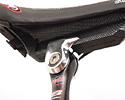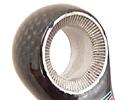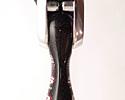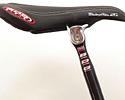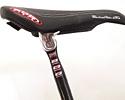
Recently on Cyclingnews.com |
On Test: SDG I-Beam Carbon seatpost and Bel-Air SL saddle, December 3, 2006
Rethinking the saddle rail

|
Speed Defies Gravity's innovative I-Beam line of saddles and seatposts has quietly taken hold among the hardcore off-road crowd and has scored successes beneath such elite riders as Geoff Kabush, Greg Minaar, and Jill Kintner. Occupying a less brightly lit corner of its lineup is the road-going version, and Cyclingnews Technical Editor James Huang checks it out to see if roadies also stand to benefit from bucking tradition.
When it was first introduced back a few years back, SDG USA's I-Beam method of saddle attachment boasted a number of claimed advantages. These included: a stronger interface, as there are no rails to bend or break; a dramatically wider range of tilt and fore-aft adjustment to accommodate the goofy geometries of some full-suspension designs; lighter weight thanks to composite saddle construction; and easier adjustments.
When considering the roadie crowd, though, the former two benefits mostly fall on deaf ears as saddle rail failures are virtually unheard of (although the advent of carbon rails throws a bit of a wrench into that statement), and frame geometries are more narrowly defined and generally don't require nearly as much range as their off-road counterparts.
Still, though, lighter weight and easier adjustments are appealing to just about everyone, and if those two goals can be achieved without compromising other attributes, then all the better.
Big yet little
SDG certainly hits the 'light' goal with its Bel-Air SL I-Beam saddle and carbon fiber I-Beam post, which weigh just 202g and 166g, respectively. While it's true that that figure won't qualify the saddle for the ultra-lightweight category, the number becomes a bit more impressive when you consider that SDG still manages to squeeze in a full-width shell, rather ample EVA foam padding, and a real leather cover (synthetic materials are lighter) along with a scuff guard out back.
As with all I-Beam saddles, the shell incorporates a single large composite 'rail' in lieu of a pair of smaller conventional ones. In the case of the Bel-Air SL, this setup allows for a whopping 75mm of total fore-aft adjustment. A pair of stiffening ribs is also molded directly into the base of the shell in order to lend a little more support. One interesting side effect of the I-Beam system is the inability to attach a conventional seat pack, but SDG does include a little clip-on bracket that is compatible with some Topeak models.
SDG's carbon I-Beam post is a decidedly minimal bit, if a tad odd-looking. The mast tapers to an almost impossibly narrow width at the top and terminates in highly polished forged 6061 aluminum head. A single bolt clamps the head on to the sides of the I-Beam saddle rail and handles both fore-aft and tilt adjustments, and graduated markings on the rear of the generously long 350mm post aid in setup. The carbon fiber I-Beam post is only available in a 27.2mm diameter, but SDG also offers an aluminum model in six commonly used sizes.
Easier to adjust? Says who?
In spite of first impressions and SDG's good intentions, setting up the I-Beam system was a frustrating experience. Once secured, the post's aluminum clamps wedge themselves around the edges of the I-Beam rail with religious fervor and are about as reluctant to let go as Democrats are of the last US presidential election results (I know you're upset, but don't you think it's about time to peel off those "Kerry-Edwards '04" bumper stickers?).
It takes a surprising amount of force to break the two bits apart in order to make fore-aft adjustments, and since the beam edges are also serrated, you can't just force the saddle back and forth as it tends to round off the teeth, which apparently results in slippage. As such, the clamps need to not only be loosened, but even opened up a bit to clear the serrations, and even then the motion still isn't all that smooth.
Likewise, the pivoting seat post head is annoyingly stepped as well. While that isn't an enormous problem in concept, the serrations are too coarse to permit truly fine tilt adjustments, and just as Murphy would have it, it was pretty much impossible to set my saddle perfectly level. Lastly, it was also difficult to make adjustments independently; tilt was pretty easy to modify on its own, but fore-aft movements could not be performed without inadvertently rotating the head as well.
1…2…3…4…5…6…
With my frustrations behind me, it was finally time to head out on the road. Thankfully, the Bel-Air SL saddle proved to be reasonably comfortable. As mentioned earlier, the saddle is rather well-padded, and although there is no cutout to speak of, SDG saw fit to equip the Bel-Air SL with a moderately deep central depression and a broad and flat overall profile that supported my sit bones well, at least when rolling along in cruising mode. The inclusion of a real leather cover was a refreshing change as well; sure, synthetics are lighter/cheaper/faster/vegan-friendly, but there still isn't a better substitute for the real deal, as far as I'm concerned.
On longer rides, however, the saddle's lack of 'give' began to take its toll. Since the I-Beam rail runs nearly the full length of the saddle base, there is no 'hammock effect' as would be found on a conventionally railed saddle. As a result, the shell of the Bel-Air SL is unyieldingly rigid, particularly through the middle. Granted, this also means that the saddle isn't likely to ever sag excessively over time as do some other lightweights, but if the shape doesn't suit you right away, you certainly can't count on it breaking in any time soon.
As far as seatposts go, the carbon I-Beam performed its job dutifully and without complaint. Our 27.2mm test model was accurately sized and slipped nary a millimeter in several frames. Potential users should be warned, though, that SDG intends this post "FOR ROAD USE ONLY", as clearly depicted on a little warning label at the bottom of the mast. If you were thinking this might be a good idea for your 'cross bike… um, well, let's just say that it doesn't sound like a great idea.
Invite over for dinner at mom and dad's, or kick it to the curb?
To be fair, the SDG Bel-Air SL and carbon fiber I-Beam seatpost combination worked reasonably well once everything was finally arranged, and riders who prefer a full-sized padded saddle yet still want minimal mass will likely be drawn to the 368g total system weight. Likewise, riders who use the same rig for both road and tri/TT events may find benefit in the extremely broad range of fore-aft adjustment that SDG's system allows. Short of that, though, the I-Beam system may be the greatest thing since sliced bread in certain situations, but unfortunately, the bulk of its advantages seems lost in this application.
Price: US$79.99 (Bel-Air SL I-Beam saddle); US$129.99 (carbon fiber
I-Beam seatpost).
Weight: 202g (Bel-Air SL I-Beam saddle with leather cover); 166g (carbon
fiber I-Beam seatpost, 27.2 x 350mm).
Pros: Surprisingly light for full-sized padded saddle.
Cons: Frustratingly difficult to adjust, overly rigid saddle.
Cyclingnews rating: ![]()
Photography
For a thumbnail gallery of these images, click here
Images by James Huang/Cyclingnews.com
- SDG's Bel-Air SL I-Beam saddle and carbon I-Beam seatpost strike an unusual profile.
- The forged aluminum clamps of the I-Beam post firmly grasp the sides of the I-Beam saddle rail.
- The Bel-Air SL I-Beam saddle shell is probably unlike most others you've seen. The shell, rail, and reinforcing ribs are all molded as one bit. A scuff guard protects the edges of the saddle in the event of impact, and a custom bag mount is compatible with some Topeak models.
- A moderately-sized depression on the Bel-Air SL saddle is intended to provide a bit of relief to sensitive areas.
- SDG's carbon I-Beam post tapers gracefully to a seemingly impossibly narrow width up top.
- The I-Beam system offers a tremendous range of fore-aft adjustment, which may prove useful for those that use a standard road bike for tri/TT applications.
- The SDG Bel-Air SL I-Beam saddle delivers 75mm of fore-aft movement, including this extreme rearward position.
- Tilt adjustments on the I-Beam post are incrementally stepped. While it is unlikely to ever slip, it is also difficult to fine-tune.
- Read the label! SDG intends the carbon fiber I-Beam post for road use only, and is apparently quite serious about it.

